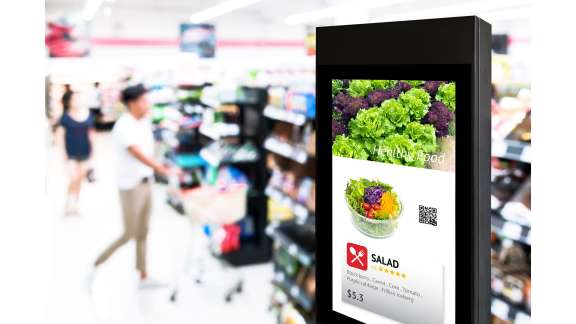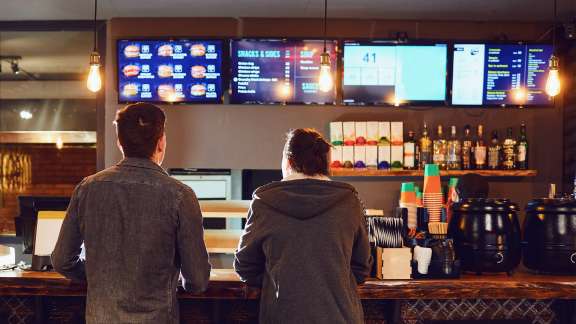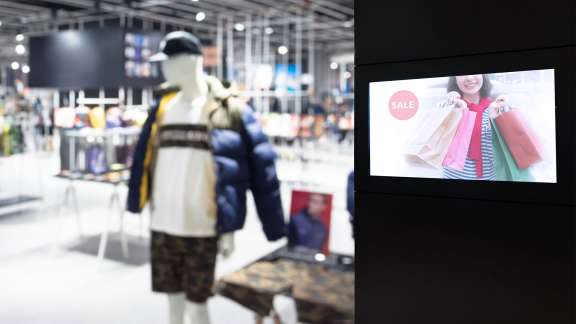Digital Out-of-Home (DOOH) is one of the fastest-growing forms of advertising. The latest digital signage solutions offer new capabilities enabled by AI and analytics, making it possible to connect brands to their target audiences with the right message at the right time. The result is eye-catching messages that make an impression, capturing the attention of consumers on the go.
What Is Digital Out-of-Home (DOOH) Advertising?
Out-of-home advertising, also known as outdoor advertising, is placed anywhere outside the consumer’s home. This could be a public space, event center, campus, major metro station, retail store, on top of a taxi, inside an elevator, and in other commercial areas. Some common examples are billboards, posters, vehicle wraps, and street furniture like bus shelters and benches.
Digital out-of-home (DOOH) advertising is a modern take on out-of-home, powered by digital signage technologies. Compared with traditional printed media, digital screens are dynamic—they can activate the right message to the right target audience at the right time.
With dynamic DOOH advertising, every screen becomes addressable, accountable, and attributable—a strategy known as “3A.”
- Addressable enables the programmatic activation of a digital advertisement.
- Accountable measures the effectiveness of the advertisement.
- Attributable measures the real business outcomes based on the advertisement.
As a result, the DOOH industry, much like the online and mobile industries, can now provide more data about audience demographics and engagement and offline-to-online attribution. This makes DOOH advertising extremely impactful. As the industry evolves from one-to-many media to one-to-select media, intelligent DOOH advertising is becoming a core part of every advertiser’s multichannel strategy.
Benefits of DOOH Advertising
The latest digital signage technologies make DOOH advertising incredibly versatile. Media networks can deliver streaming ads in a bustling transit station, timely and relevant promotions in a shopping center, or high-definition visuals on a digital billboard at a high-traffic intersection.
| DOOH Advertising Offers Several Advantages Over Printed Media or Other Types of Advertising: |
|
|---|---|
| Target with greater impact |
Because ads can be changed over the course of the day or week, digital advertisements can do a better job targeting the right audiences. |
| Measure results and refine strategies |
When paired with analytics, digital signage offers real-time attribution data and impact, both offline-to offline, and offline-to-online. This helps media networks and their customers increase the impact of their advertising efforts. |
Programmatic DOOH Advertising
When it comes to outdoor media networks selling their advertising space, DOOH offers another key advantage with its support of programmatic platforms.
With printed media, advertisers must contact the network owner and directly negotiate the details of a campaign. With digital signage, content is controlled by software, making it much easier to manage and adapt with customer insights. This enables programmatic advertising, in which a media buyer can access a network’s inventory and book placements based on their desired audience demographics. As a result, advertisers can reach just the audience they’re looking for.
Marketing Analytics with DOOH
The most recent wave of digital signage has added new capabilities for analytics. It can determine how many people passed the sign, how many people viewed it, and how much time they spent looking at it. In some cases, it can even tell when a customer has walked into a store. This leads to two key opportunities.
First, sensors on screens can conduct market research for brands, and not just in fixed positions but also on the go, if they are part of next-generation transport solutions. By using anonymized data, sensors and cameras can provide real-time insights into topics traditionally captured by surveys—such as brands and colors that are trending.
Second, media networks can provide better information about target audiences to their buyers. Not only do they know who is passing by, but they can also get a sense of who is paying attention to different types of advertisements.
Intel® Technologies for DOOH Signage
Every digital screen presents an opportunity to capture advertising revenue. Intel® technologies for digital signage help make the most of these opportunities. From small screens on interactive kiosks to large-format digital billboards, Intel®-based solutions provide the compute performance, high-quality graphics, and connectivity to make an impression—plus the analytics to reveal valuable insights.
- Intel® Core™ processors provide the performance for bold, attention-grabbing visuals, high-definition video, and responsive touchscreens. They’re also powerful enough to support new AI-enabled capabilities and analytics.
- The Intel vPro® platform offers business-class performance, sophisticated, hardware-based remote management capabilities, and more.
- Hardware-enabled security features are built into Intel® technologies.
- The Intel® Distribution of OpenVINO™ toolkit streamlines the process of deploying computer vision across a range of Intel platforms. By adding vision capabilities to digital signage, media networks and advertisers have new ways to measure the addressability, accountability, and attribution of campaigns.
Know Your Audience
While digital signage itself can create dynamic, on-brand experiences, media networks and advertisers will get the most from these assets with the right analytics. A modern outdoor media strategy draws from the data collected every moment of the day as consumers walk by or engage with digital signage. By putting this data to work, media networks can better serve their buyers and advertisers can engage in more meaningful ways with their audiences.




